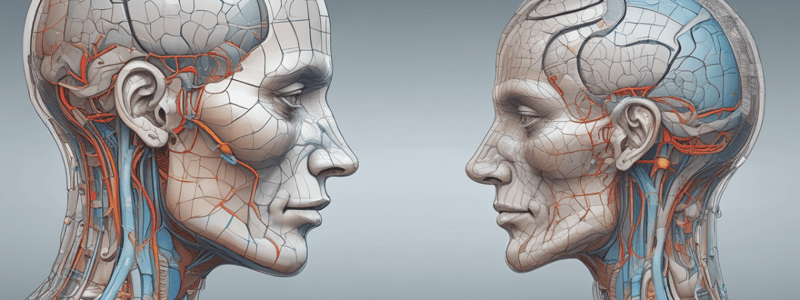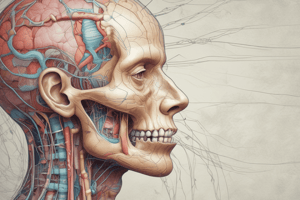Podcast
Questions and Answers
What type of sensory information is transmitted through the dorsal column-medial lemniscus pathway?
What type of sensory information is transmitted through the dorsal column-medial lemniscus pathway?
- Pain and temperature
- Smell and taste
- Proprioception, vibration, and fine touch (correct)
- Hearing and balance
Which cranial nerve is responsible for transmitting visual information?
Which cranial nerve is responsible for transmitting visual information?
- Trochlear nerve (CN IV)
- Olfactory nerve (CN I)
- Optic nerve (CN II) (correct)
- Oculomotor nerve (CN III)
What type of sensory information is transmitted through the lateral spinothalamic pathway?
What type of sensory information is transmitted through the lateral spinothalamic pathway?
- Fast pain and temperature (correct)
- Hearing and balance
- Slow pain and temperature
- Proprioception, vibration, and fine touch
Which cranial nerve is responsible for controlling facial expressions and taste?
Which cranial nerve is responsible for controlling facial expressions and taste?
Which motor control system is responsible for involuntary movements, such as tremors and rigidity?
Which motor control system is responsible for involuntary movements, such as tremors and rigidity?
Which motor control system coordinates and regulates motor movements, particularly those requiring fine motor control and balance?
Which motor control system coordinates and regulates motor movements, particularly those requiring fine motor control and balance?
Match the following structures with their compositions:
Match the following structures with their compositions:
Match the following cranial nerves with their functions:
Match the following cranial nerves with their functions:
Match the following functions with the correct structure:
Match the following functions with the correct structure:
Match the following cranial nerves with their respective numbers:
Match the following cranial nerves with their respective numbers:
Match the following functions with the correct cranial nerve:
Match the following functions with the correct cranial nerve:
Match the following structures with their locations:
Match the following structures with their locations:
Match the following spinal cord regions with their corresponding functions:
Match the following spinal cord regions with their corresponding functions:
Match the following spinal cord structures with their compositions:
Match the following spinal cord structures with their compositions:
Match the following cranial nerves with their functions:
Match the following cranial nerves with their functions:
Match the following spinal cord regions with their locations:
Match the following spinal cord regions with their locations:
Match the following cranial nerves with their functions:
Match the following cranial nerves with their functions:
Match the following spinal cord structures with their locations:
Match the following spinal cord structures with their locations:
The spinal cord is protected by the ______ column.
The spinal cord is protected by the ______ column.
The spinal cord is a long, thin, tube-like structure extending from the base of the ______ down to the lower back.
The spinal cord is a long, thin, tube-like structure extending from the base of the ______ down to the lower back.
The spinal cord is composed of gray matter, which is made up of ______ cells and their supporting cells.
The spinal cord is composed of gray matter, which is made up of ______ cells and their supporting cells.
The spinal cord transmits messages between the ______ and the rest of the body.
The spinal cord transmits messages between the ______ and the rest of the body.
The cranial nerve responsible for carrying sensory information related to ______ is the Olfactory Nerve (I).
The cranial nerve responsible for carrying sensory information related to ______ is the Olfactory Nerve (I).
The Vagus Nerve (X) regulates various bodily functions, including ______ rate.
The Vagus Nerve (X) regulates various bodily functions, including ______ rate.
What is the main function of the spinal cord in relation to the brain and the rest of the body?
What is the main function of the spinal cord in relation to the brain and the rest of the body?
What is the outer region of the spinal cord composed of?
What is the outer region of the spinal cord composed of?
What is the function of the spinal cord segment responsible for controlling voluntary movements?
What is the function of the spinal cord segment responsible for controlling voluntary movements?
What is the function of the root of the cranial nerve responsible for facial expressions?
What is the function of the root of the cranial nerve responsible for facial expressions?
What is the function of the cranial nerve responsible for transmitting auditory information?
What is the function of the cranial nerve responsible for transmitting auditory information?
What is the function of the spinal cord region responsible for regulating pain and temperature sensations?
What is the function of the spinal cord region responsible for regulating pain and temperature sensations?
Study Notes
Cranial Nerve Functions
- 12 pairs of cranial nerves (CN) emerge from the brain stem, responsible for various sensory and motor functions
- Sensory functions:
- Olfactory nerve (CN I): smell
- Optic nerve (CN II): vision
- Oculomotor nerve (CN III): eye movement, pupil constriction
- Trochlear nerve (CN IV): superior oblique muscle (eye rotation)
- Trigeminal nerve (CN V): facial sensation, motor control for chewing
- Auditory nerve (CN VIII): hearing, balance
- Motor functions:
- Oculomotor nerve (CN III): eye movement, eyelid lifting
- Trochlear nerve (CN IV): superior oblique muscle (eye rotation)
- Trigeminal nerve (CN V): motor control for chewing
- Facial nerve (CN VII): facial expressions, taste
- Glossopharyngeal nerve (CN IX): swallowing, salivation
- Vagus nerve (CN X): pharyngeal and laryngeal muscles
- Other functions:
- Abducens nerve (CN VI): lateral rectus muscle (eye movement)
- Accessory nerve (CN XI): neck and shoulder movement
- Hypoglossal nerve (CN XII): tongue movement
Sensory Pathways
- Dorsal column-medial lemniscus pathway:
- Transmits proprioception, vibration, and fine touch information from the body to the brain
- Signals travel from sensory receptors to the dorsal column, then to the medulla oblongata, and finally to the thalamus
- Anterior spinothalamic pathway:
- Transmits pain and temperature information from the body to the brain
- Signals travel from sensory receptors to the spinal cord, then to the thalamus
- Lateral spinothalamic pathway:
- Transmits fast pain and temperature information from the body to the brain
- Signals travel from sensory receptors to the spinal cord, then to the thalamus
Motor Control Systems
- Pyramidal system:
- Direct motor pathway from the cerebral cortex to the spinal cord
- Responsible for voluntary movements, such as walking and grasping
- Extrapyramidal system:
- Indirect motor pathway from the basal ganglia to the spinal cord
- Involved in involuntary movements, such as tremors and rigidity
- Cerebellar system:
- Coordinates and regulates motor movements, particularly those requiring fine motor control and balance
- Receives input from sensory receptors, spinal cord, and cerebral cortex
Studying That Suits You
Use AI to generate personalized quizzes and flashcards to suit your learning preferences.
Description
Learn about the 12 cranial nerves, their functions, and the sensory and motor pathways in the human body, including the dorsal column-medial lemniscus pathway, pyramidal system, and cerebellar system.




